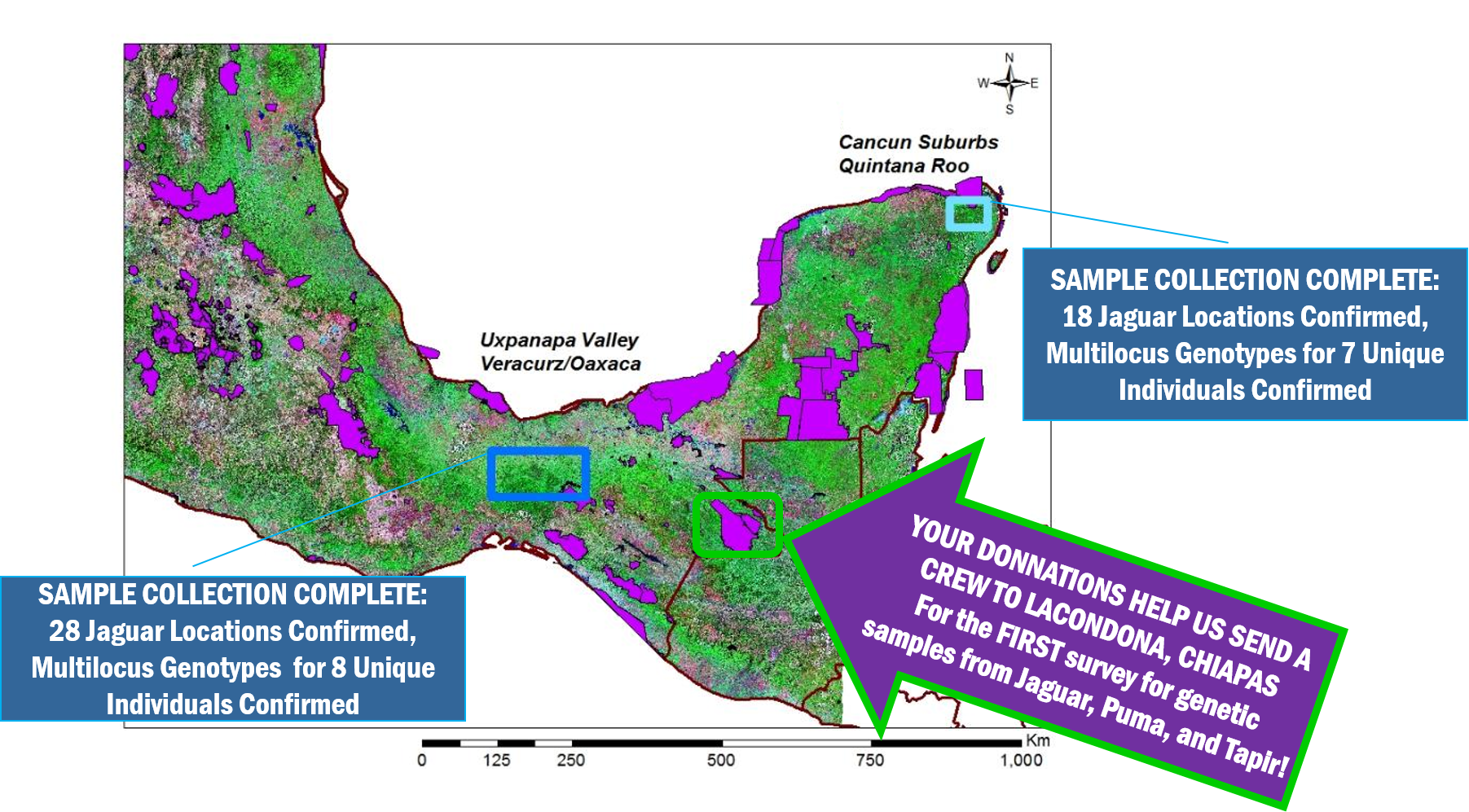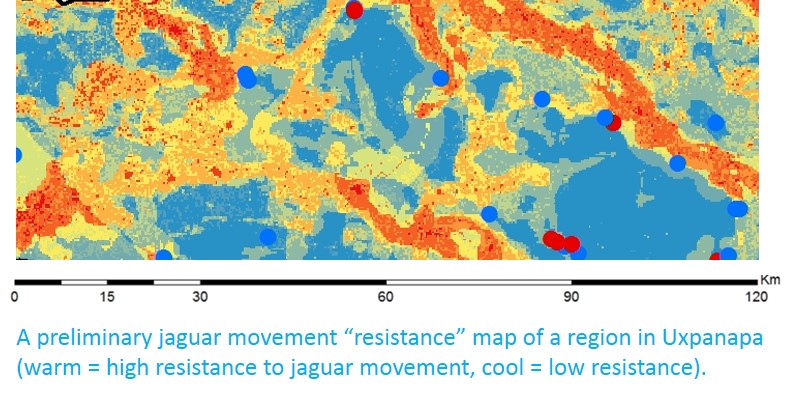Jennifer Mae-White Day
Dogs, Cats, and Scats: Saving Jaguars,
One Poop at a Time
Posted 14 Nov 2014 102 Backers
How do Molecular Ecologists use Jaguar
Scat for Conservation Science?
Scat for Conservation Science?
Step One: Since jaguars cover a lot of ground – we need
to too.
to too.
We have surveyed two locations in
southern Mexico to date for jaguar and
puma scat, in partnership with University
of Veracruz’s Centro de Investigaciones
Tropicales (CITRO) and the Reserva
Ecologica El Eden. There are not many
jaguars left at these sites, so we were not
sure what we would find. It turns out
that the Conservation Canines are experts
at finding jaguar scat.
In the Uxpanapa
Valley of Veracurz, we ended up with 28
jaguar locations confirmed, and 8 unique
multilocus genotypes from scat samples
(genotypes are genetic information that
allow us to tell individuals apart,
relatedness between individuals, and to
assess genetic diversity). That may not
sound like a big number, but that's
potentially a THIRD of the entire
population of the valley!
southern Mexico to date for jaguar and
puma scat, in partnership with University
of Veracruz’s Centro de Investigaciones
Tropicales (CITRO) and the Reserva
Ecologica El Eden. There are not many
jaguars left at these sites, so we were not
sure what we would find. It turns out
that the Conservation Canines are experts
at finding jaguar scat.
In the Uxpanapa
Valley of Veracurz, we ended up with 28
jaguar locations confirmed, and 8 unique
multilocus genotypes from scat samples
(genotypes are genetic information that
allow us to tell individuals apart,
relatedness between individuals, and to
assess genetic diversity). That may not
sound like a big number, but that's
potentially a THIRD of the entire
population of the valley!

Step Two: Waste not, want not.
When species are rare, endangered, or
just hard to find, getting every scrap
of information from each sample is vital.
Scat contains an amazing amount of
information, but it takes a lot of hard
work to pull that information out.
Many of the genetic or hormone tools
available today do not work well on
feces, or require a special set of
protocols to get accurate results.
We at UW's Center for Conservation
Biology have spent many years
developing ways of getting genetic,
hormone, and toxin data from fecal
samples – you could call us expert
scatologists!
just hard to find, getting every scrap
of information from each sample is vital.
Scat contains an amazing amount of
information, but it takes a lot of hard
work to pull that information out.
Many of the genetic or hormone tools
available today do not work well on
feces, or require a special set of
protocols to get accurate results.
We at UW's Center for Conservation
Biology have spent many years
developing ways of getting genetic,
hormone, and toxin data from fecal
samples – you could call us expert
scatologists!
After a lot of trial and error in
the early years of my PhD program,
I now have a great set of molecular
markers to tell species apart, assign
multi-locus genotypes, and even
measure T3 thyroid and
glucocorticoid stress hormones
from jaguar scat!

Step Three: Show me the Data!
From scat locations, we evaluate
what constitutes jaguar habitat via
resource selection probability
functions (RSPF). RSPF specifically
tells us what features in the landscape
attract or repel jaguars. This phase of
the analysis will help us answer
questions like: Are jaguars really as
sensitive to human activity as we
once thought? Is their attraction to
water stronger than their avoidance
of roads or villages? From the
results of the RSPF analysis, we
can predict the level of connectivity
of the landscape with geographic
models that apply electrical circuit
theory to model wildlife movement.
The best part of this type of
connectivity analysis is that it
identifies out specific ‘pinch-points’
on the landscape. These pinch-points
are places that can be targeted for
conservation efforts, because they
provide the biggest benefit to the
connectivity of the whole system.
This is a great way to focus limited
conservation resources to specific
geographic locations that will
provide the most benefit to the
population as a whole!
what constitutes jaguar habitat via
resource selection probability
functions (RSPF). RSPF specifically
tells us what features in the landscape
attract or repel jaguars. This phase of
the analysis will help us answer
questions like: Are jaguars really as
sensitive to human activity as we
once thought? Is their attraction to
water stronger than their avoidance
of roads or villages? From the
results of the RSPF analysis, we
can predict the level of connectivity
of the landscape with geographic
models that apply electrical circuit
theory to model wildlife movement.
The best part of this type of
connectivity analysis is that it
identifies out specific ‘pinch-points’
on the landscape. These pinch-points
are places that can be targeted for
conservation efforts, because they
provide the biggest benefit to the
connectivity of the whole system.
This is a great way to focus limited
conservation resources to specific
geographic locations that will
provide the most benefit to the
population as a whole!

I am particularly interested in how
landscape features impact not only
movement, but also gene-flow within
and between populations. Gene-flow
is the ultimate measurement of
functional habitat connectivity
(not only where could they migrate,
but where they actually migrate AND
reproduce). Using the multilocus
genotypes from scat, I am analyzing
genetic patterns within (landscape
genetics) and among (population
genetics) putative populations. With
the addition of this third field site, we
will have an amazing ability to
compare how different human pressures
affect gene-flow. The goal of this
analysis will be, again, to make
conservation efforts most effective.
For example, to maximize gene-flow,
should we focus efforts on protecting
the remaining forest fragments, or
improving the connectivity between
them with corridors? WITH YOUR
HELP, we will have an entirely new
set of genetic data to add to our
analysis – from an area that has
never been studied before!
landscape features impact not only
movement, but also gene-flow within
and between populations. Gene-flow
is the ultimate measurement of
functional habitat connectivity
(not only where could they migrate,
but where they actually migrate AND
reproduce). Using the multilocus
genotypes from scat, I am analyzing
genetic patterns within (landscape
genetics) and among (population
genetics) putative populations. With
the addition of this third field site, we
will have an amazing ability to
compare how different human pressures
affect gene-flow. The goal of this
analysis will be, again, to make
conservation efforts most effective.
For example, to maximize gene-flow,
should we focus efforts on protecting
the remaining forest fragments, or
improving the connectivity between
them with corridors? WITH YOUR
HELP, we will have an entirely new
set of genetic data to add to our
analysis – from an area that has
never been studied before!

.jpg)











No comments:
Post a Comment